Difference between revisions of "QA/dev gui testing"
| Line 6: | Line 6: | ||
[http://junit.sourceforge.net/doc/cookbook/cookbook.htm Here] is a short cookbook showing how to use JUnit 4. If you know Java, it's very easy for you to understand it. | [http://junit.sourceforge.net/doc/cookbook/cookbook.htm Here] is a short cookbook showing how to use JUnit 4. If you know Java, it's very easy for you to understand it. | ||
| − | == Write test | + | == Write GUI test case == |
| + | === A simple example === | ||
| + | You can find one simple example in the testgui project. The source code is testgui/source/testcase/gui/AOOTest.java. | ||
<source lang="java"> | <source lang="java"> | ||
| − | package testcase; | + | package testcase.gui; |
import static org.junit.Assert.*; | import static org.junit.Assert.*; | ||
| − | import static testlib.AppUtil.*; | + | import static testlib.gui.AppUtil.*; |
| − | import static | + | import static testlib.gui.UIMap.*; |
| + | import org.junit.After; | ||
import org.junit.Before; | import org.junit.Before; | ||
import org.junit.Rule; | import org.junit.Rule; | ||
import org.junit.Test; | import org.junit.Test; | ||
| − | import testlib.CalcUtil; | + | import testlib.gui.CalcUtil; |
| − | import testlib.Log; | + | import testlib.gui.Log; |
/** | /** | ||
| − | * | + | * If AOO is not installed in the default directory, please specify the system property in your command line. <br/> |
| − | * | + | * -Dopenoffice.home="Your OpenOffice installation directory which contains soffice.bin" |
| − | |||
* | * | ||
*/ | */ | ||
| − | public class | + | public class AOOTest { |
/** | /** | ||
| − | * | + | * Add Log to enable the following capabilities. |
* 1. Take a screenshot when failure occurs. | * 1. Take a screenshot when failure occurs. | ||
* 2. Collect extra data when OpenOffice crashes. | * 2. Collect extra data when OpenOffice crashes. | ||
| + | * 3. Log any detail information. | ||
*/ | */ | ||
@Rule | @Rule | ||
public Log LOG = new Log(); | public Log LOG = new Log(); | ||
| − | + | ||
| + | /** | ||
| + | * Do some setup task before running test | ||
| + | * @throws Exception | ||
| + | */ | ||
@Before | @Before | ||
public void setUp() throws Exception { | public void setUp() throws Exception { | ||
| − | app.start(); | + | //Start OpenOffice with a clean user profile |
| + | app.start(true); | ||
} | } | ||
| + | /** | ||
| + | * Clean task after testing | ||
| + | * @throws Exception | ||
| + | */ | ||
@After | @After | ||
public void tearDown() throws Exception { | public void tearDown() throws Exception { | ||
| − | + | ||
} | } | ||
| − | + | ||
/** | /** | ||
| − | * Implement | + | * Implement test steps |
*/ | */ | ||
@Test | @Test | ||
| − | public void | + | public void testHello() { |
startcenter.menuItem("File->New->Spreadsheet").select(); | startcenter.menuItem("File->New->Spreadsheet").select(); | ||
calc.waitForExistence(10, 3); | calc.waitForExistence(10, 3); | ||
| Line 61: | Line 73: | ||
} | } | ||
| − | |||
| − | |||
| − | |||
| − | |||
| − | |||
| − | |||
| − | |||
| − | |||
| − | |||
| − | |||
</source> | </source> | ||
| + | === testlib.gui.UIMap === | ||
The classes under package org.openoffice.test.vcl.widgets can be used to interact with VCL controls. Generally, we should specify control's Help ID to construct these classes. Then invoke other methods to perform user actions. | The classes under package org.openoffice.test.vcl.widgets can be used to interact with VCL controls. Generally, we should specify control's Help ID to construct these classes. Then invoke other methods to perform user actions. | ||
<source lang="java"> | <source lang="java"> | ||
| Line 84: | Line 87: | ||
String selected = someListBox.getSelText(); | String selected = someListBox.getSelText(); | ||
</source> | </source> | ||
| − | |||
| − | === How to | + | Generally we define GUI controls centrally in one class named testlib.gui.UIMap. The advantage is that we can easily update our scripts when GUI changes. There have been many pre-defined controls. For example: |
| + | *app: The whole AOO application | ||
| + | *startcenter: Startcenter window | ||
| + | *writer: Writer window | ||
| + | *calc: Calc window | ||
| + | *impress: Impress window. | ||
| + | You can define new GUI control by add one line in the class or use one Eclipse plugin named testassistant to simplify the thing. | ||
| + | |||
| + | |||
| + | === How to define GUI controls === | ||
''' Use VCL Test Assistant Eclipse Plugin '''<br /> | ''' Use VCL Test Assistant Eclipse Plugin '''<br /> | ||
Install the plugin into your eclipse.<br /> | Install the plugin into your eclipse.<br /> | ||
| Line 101: | Line 112: | ||
If you want to use any control, left double click on the "Name" item of the control which you want to use, then add a name to it. Then you will find a UI control defined automatically in the last line of UIMap.java.(%EclipseWorkspaceDir%\test\testscript\src\testlib\UIMap.java). Then you can use the control by name you defined instead of using control ID. | If you want to use any control, left double click on the "Name" item of the control which you want to use, then add a name to it. Then you will find a UI control defined automatically in the last line of UIMap.java.(%EclipseWorkspaceDir%\test\testscript\src\testlib\UIMap.java). Then you can use the control by name you defined instead of using control ID. | ||
[[File:Add_controls.png]]<br /> | [[File:Add_controls.png]]<br /> | ||
| + | |||
| + | === testlib.gui.AppUtil === | ||
| + | testlib.gui.AppUtil inludes some methods to post keyboard/mouse event to OS. | ||
| + | <source lang="java"> | ||
| + | AppUtil.typeKeys("AB<enter>"); | ||
| + | //type shortcuts | ||
| + | AppUtil.typeKeys("<ctrl a><ctrl c><ctrl v>"); | ||
| + | //Perform mouse click on screen | ||
| + | AppUtil.click(200, 200); | ||
| + | </source> | ||
=== Add a Test Case === | === Add a Test Case === | ||
Revision as of 01:29, 13 August 2012
JUnit 4 basics
Here is a short cookbook showing how to use JUnit 4. If you know Java, it's very easy for you to understand it.
Write GUI test case
A simple example
You can find one simple example in the testgui project. The source code is testgui/source/testcase/gui/AOOTest.java.
package testcase.gui;
import static org.junit.Assert.*;
import static testlib.gui.AppUtil.*;
import static testlib.gui.UIMap.*;
import org.junit.After;
import org.junit.Before;
import org.junit.Rule;
import org.junit.Test;
import testlib.gui.CalcUtil;
import testlib.gui.Log;
/**
* If AOO is not installed in the default directory, please specify the system property in your command line. <br/>
* -Dopenoffice.home="Your OpenOffice installation directory which contains soffice.bin"
*
*/
public class AOOTest {
/**
* Add Log to enable the following capabilities.
* 1. Take a screenshot when failure occurs.
* 2. Collect extra data when OpenOffice crashes.
* 3. Log any detail information.
*/
@Rule
public Log LOG = new Log();
/**
* Do some setup task before running test
* @throws Exception
*/
@Before
public void setUp() throws Exception {
//Start OpenOffice with a clean user profile
app.start(true);
}
/**
* Clean task after testing
* @throws Exception
*/
@After
public void tearDown() throws Exception {
}
/**
* Implement test steps
*/
@Test
public void testHello() {
startcenter.menuItem("File->New->Spreadsheet").select();
calc.waitForExistence(10, 3);
typeKeys("Hello");
assertEquals("Assert", "Hello", CalcUtil.getCellInput("A1"));
}
}
testlib.gui.UIMap
The classes under package org.openoffice.test.vcl.widgets can be used to interact with VCL controls. Generally, we should specify control's Help ID to construct these classes. Then invoke other methods to perform user actions.
VclWindow startcenter = new VclWindow("FWK_HID_BACKINGWINDOW");
startcenter.click();
VclButton someButton = new VclButton("SC_HID_INSWIN_CALC");
someButton.click();
boolean checked = someButton.getText();
VclListBox someListBox = new VclListBox("some.listbox.id");
someListBox.select("Item1");
String selected = someListBox.getSelText();
Generally we define GUI controls centrally in one class named testlib.gui.UIMap. The advantage is that we can easily update our scripts when GUI changes. There have been many pre-defined controls. For example:
- app: The whole AOO application
- startcenter: Startcenter window
- writer: Writer window
- calc: Calc window
- impress: Impress window.
You can define new GUI control by add one line in the class or use one Eclipse plugin named testassistant to simplify the thing.
How to define GUI controls
Use VCL Test Assistant Eclipse Plugin
Install the plugin into your eclipse.
File:Testassistant.zip
Open Eclipse Preferences, find the page "VCL Test Assistant" and then specify OpenOffice installation directory.
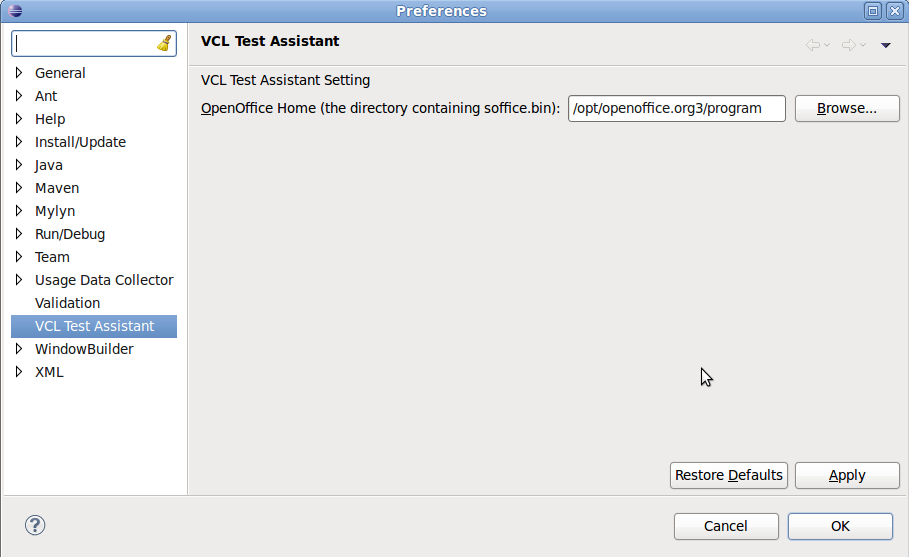
Open "VCL Test Assistant->VCL Explorer" view.
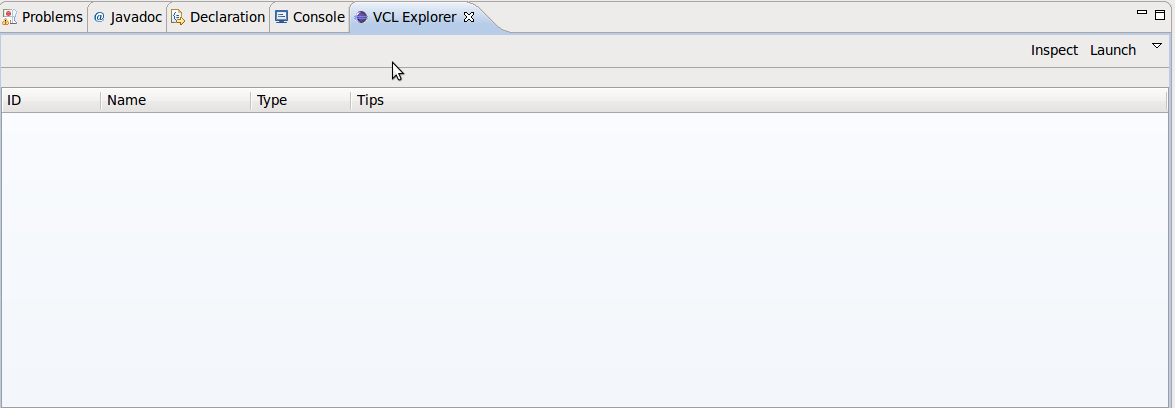
Click Launch to start OpenOffice and then click Inspect.
Now, OpenOffice will pops up a floating windows titled "DisplayHID". Drag the gray circle to some controls and then release the button.
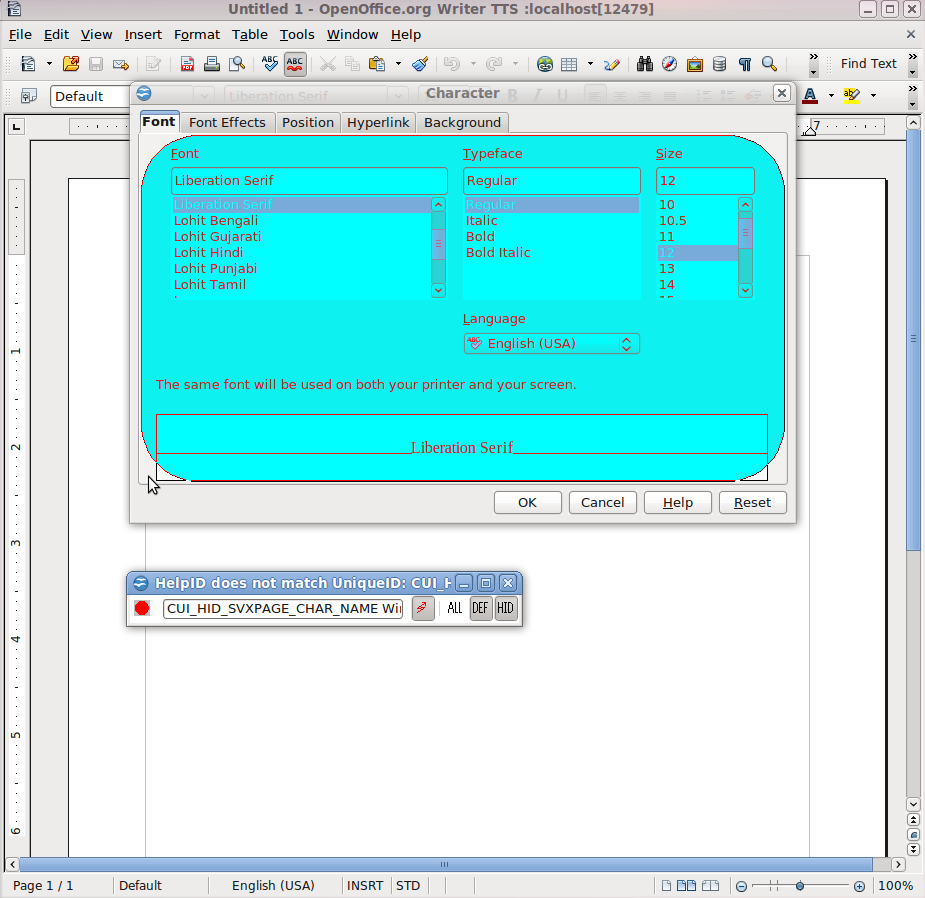
Go back to VCL Explorer, you will get the Help IDs.
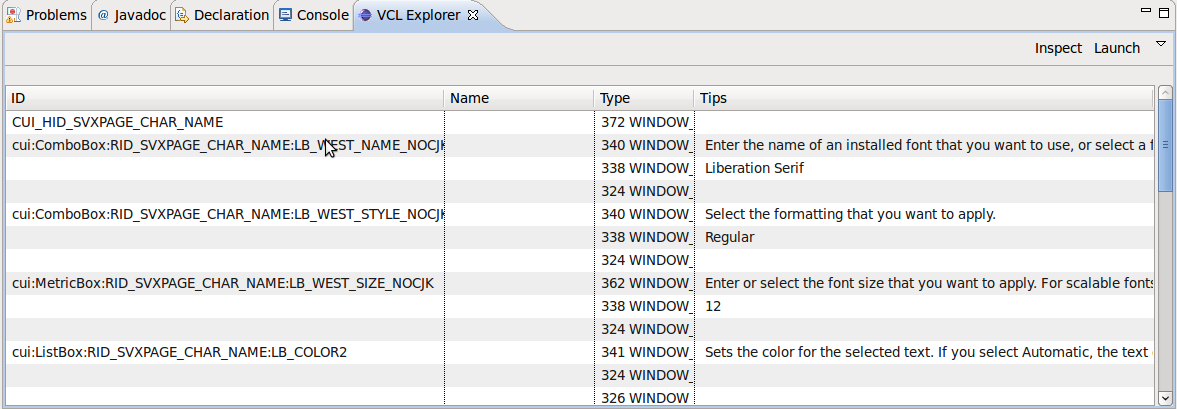
If you want to use any control, left double click on the "Name" item of the control which you want to use, then add a name to it. Then you will find a UI control defined automatically in the last line of UIMap.java.(%EclipseWorkspaceDir%\test\testscript\src\testlib\UIMap.java). Then you can use the control by name you defined instead of using control ID.
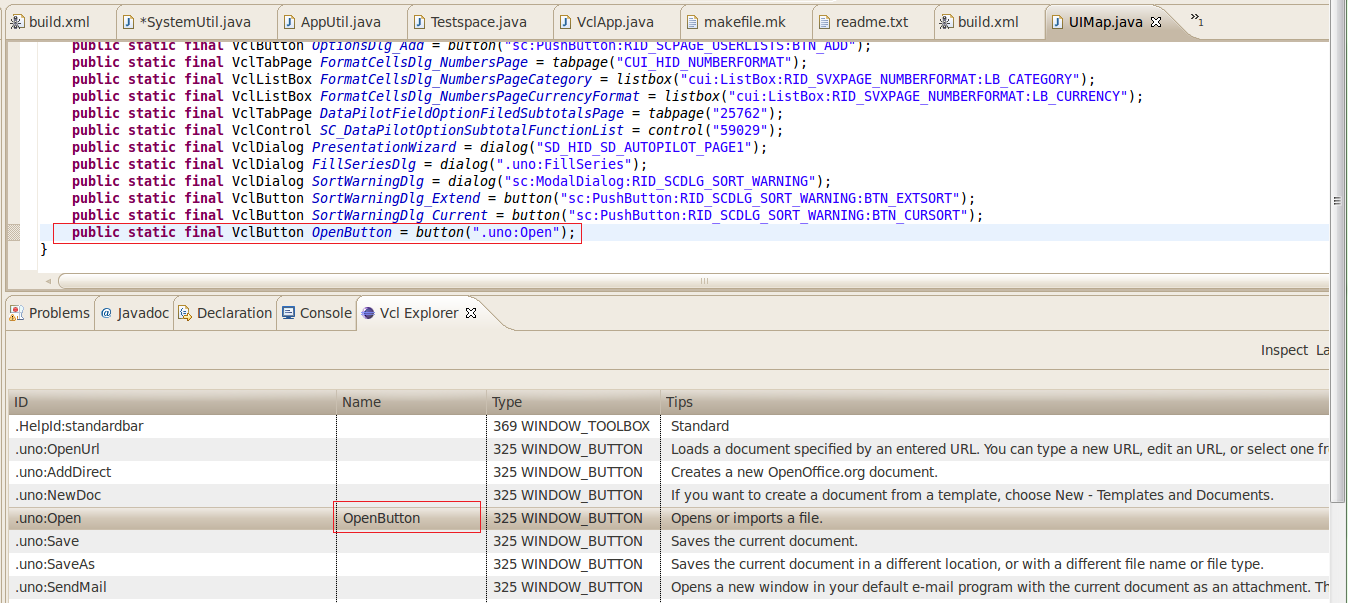
testlib.gui.AppUtil
testlib.gui.AppUtil inludes some methods to post keyboard/mouse event to OS.
AppUtil.typeKeys("AB<enter>");
//type shortcuts
AppUtil.typeKeys("<ctrl a><ctrl c><ctrl v>");
//Perform mouse click on screen
AppUtil.click(200, 200);
Add a Test Case
Best practice
Basic rules for JUnit 4
1. Don't us random. That makes test uncertain, hard to debug and maintain. Instead of it, prepare enough special test data to cover boundary conditions. 2. Name tests properly. "testLoadFileFromServer" is better than "test". 3. Clean up in @After/@AfterClass method to avoid affecting other testcases.
Special ruls for GUI testing
1. Every test case should have verification point.
e.g. Test scenario: Inserting a table in text document.
After you inserting a table in the document, you have to verify whether the table is inserted successfully.
2. Make sure test codes are concise, readable and easy to maintain.
3. In VCLAuto, “sleep()” is usually not needed. Here is some special situation “sleep()” is needed.
- Open a file. If you want to do some operations based on a sample file or a new created file. “sleep()” is needed to wait for the file opened successfully.
4. Make sure test codes have no warnings.
5. When you add a new class, remember to add AOO license in front of the class.
6. Put same operations into “@Before” method to avoid codes redundant.
7. Use Ctrl+A, then Ctrl+Shift+F to format source code when you complete all the codes.
8. Test all the test codes on windows/mac/linux platforms before committing.